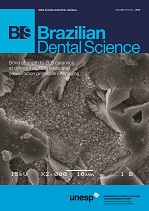Effects of Ferrule and Diameter of Parallel Cast Post and Core on Fracture Resistance
DOI:
https://doi.org/10.14295/bds.2019.v22i4.1720Abstract
Objectives: The aim of this study was to evaluate the effects of using different diameters of parallel cast posts with, or without ferrule, on the overall fracture resistance of Cast Post and Core (CPC).
Material and methods: Forty (40) endodontically treated human maxillary central incisors were divided into four groups (n=10): [F1] 1.0 mm diameter post with ferrule; [NF1] 1.0 mm diameter cast post without ferrule; [F1.5] 1.5 mm diameter cast post with ferrule; [NF1.5] 1.5 mm diameter post without ferrule. For all teeth, the post space (9.0 mm, in depth) was prepared using ParaPostTM drill. CPC using base metal alloy were fabricated and were cemented using resin modified glass ionomer (RMGI) cement along with the PFM crowns. A universal testing machine (Instron) was used to apply horizontal force perpendicular to the long axis of the tooth at the center of lingual surface, until catastrophic failure. Data was submitted to two-way ANOVA and Scheffé tests (P<0.05).
Results: Both post diameter and ferrule statistically affected the maximum load at fracture (P=0.004 and P=0.013, respectively). The highest mean values were observed for samples with ferrule and wider post size (490N), while the lowest were observed for samples without ferrule and narrower post size (254N). There was no relationship between the presence of a ferrule and post size (P=0.937).
Conclusions: For endodontically treated teeth with no ferrule, a wider-diameter cast post increases fracture resistance of a CPC and PFM crown procedure.
Downloads
Downloads
Additional Files
Published
How to Cite
Issue
Section
License
Brazilian Dental Science uses the Creative Commons (CC-BY 4.0) license, thus preserving the integrity of articles in an open access environment. The journal allows the author to retain publishing rights without restrictions.
=================




























